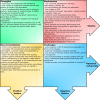Mobile and Wearable Technology for the Monitoring of Diabetes-Related Parameters: Systematic Review
- PMID: 34081010
- PMCID: PMC8212630
- DOI: 10.2196/25138
Mobile and Wearable Technology for the Monitoring of Diabetes-Related Parameters: Systematic Review
Abstract
Background: Diabetes mellitus is a metabolic disorder that affects hundreds of millions of people worldwide and causes several million deaths every year. Such a dramatic scenario puts some pressure on administrations, care services, and the scientific community to seek novel solutions that may help control and deal effectively with this condition and its consequences.
Objective: This study aims to review the literature on the use of modern mobile and wearable technology for monitoring parameters that condition the development or evolution of diabetes mellitus.
Methods: A systematic review of articles published between January 2010 and July 2020 was performed according to the PRISMA (Preferred Reporting Items for Systematic Reviews and Meta-Analyses) guidelines. Manuscripts were identified through searching the databases Web of Science, Scopus, and PubMed as well as through hand searching. Manuscripts were included if they involved the measurement of diabetes-related parameters such as blood glucose level, performed physical activity, or feet condition via wearable or mobile devices. The quality of the included studies was assessed using the Newcastle-Ottawa Scale.
Results: The search yielded 1981 articles. A total of 26 publications met the eligibility criteria and were included in the review. Studies predominantly used wearable devices to monitor diabetes-related parameters. The accelerometer was by far the most used sensor, followed by the glucose monitor and heart rate monitor. Most studies applied some type of processing to the collected data, mainly consisting of statistical analysis or machine learning for activity recognition, finding associations among health outcomes, and diagnosing conditions related to diabetes. Few studies have focused on type 2 diabetes, even when this is the most prevalent type and the only preventable one. None of the studies focused on common diabetes complications. Clinical trials were fairly limited or nonexistent in most of the studies, with a common lack of detail about cohorts and case selection, comparability, and outcomes. Explicit endorsement by ethics committees or review boards was missing in most studies. Privacy or security issues were seldom addressed, and even if they were addressed, they were addressed at a rather insufficient level.
Conclusions: The use of mobile and wearable devices for the monitoring of diabetes-related parameters shows early promise. Its development can benefit patients with diabetes, health care professionals, and researchers. However, this field is still in its early stages. Future work must pay special attention to privacy and security issues, the use of new emerging sensor technologies, the combination of mobile and clinical data, and the development of validated clinical trials.
Keywords: diabetes; mobile phone; monitoring; passive sensing; smartphone; wearable.
©Ciro Rodriguez-León, Claudia Villalonga, Manuel Munoz-Torres, Jonatan R Ruiz, Oresti Banos. Originally published in JMIR mHealth and uHealth (https://mhealth.jmir.org), 03.06.2021.
Conflict of interest statement
Conflicts of Interest: None declared.
Figures


References
-
- Baena-Díez JM, Peñafiel J, Subirana I, Ramos R, Elosua R, Marín-Ibañez A, Guembe MJ, Rigo F, Tormo-Díaz MJ, Moreno-Iribas C, Cabré JJ, Segura A, García-Lareo M, de la Cámara AG, Lapetra J, Quesada M, Marrugat J, Medrano MJ, Berjón J, Frontera G, Gavrila D, Barricarte A, Basora J, García JM, Pavone NC, Lora-Pablos D, Mayoral E, Franch J, Mata M, Castell C, Frances A, Grau M, FRESCO Investigators Risk of cause-specific death in individuals with diabetes: a competing risks analysis. Diabetes Care. 2016 Nov;39(11):1987–95. doi: 10.2337/dc16-0614. - DOI - PubMed
-
- IDF Diabetes Atlas: Ninth Edition 2019. Belgium: International Diabetes Federation; 2019. pp. 1–176.
-
- IDF Diabetes Atlas 8th Ed 2017. Belgium: International Diabetes Federation; 2017. pp. 1–150.
-
- Classification of Diabetes Mellitus 2019. Geneva: World Health Organization; 2019. pp. 1–40.
Publication types
MeSH terms
Substances
LinkOut - more resources
Full Text Sources
Medical
Miscellaneous

